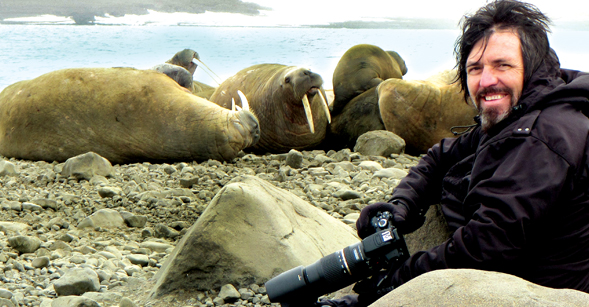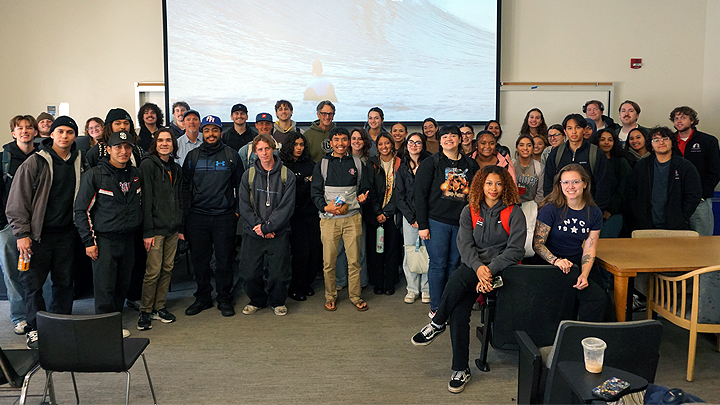Where in the World
Biology professor Forest Rohwer defied Arctic climes to seek out nature's most diverse forms of life.

This story is featured in the spring 2014 issue of 360:The Magazine of San Diego State University.
Virus. The word brings to mind illness, infection, even death. But should it?
Marine microbial ecologist, Forest Rohwer would say we have it all wrong. A pioneer in the study of microbes and viruses, Rohwer is an ardent admirer of the tiny organisms whose reason d’etre remains a mystery to scientists.
“Most of biology has been thinking about it backward,” Rohwer maintains. “We never studied viruses until recently because we didn’t know they existed. Actually, there are more viruses and they have more diversity than any other living thing. To understand the biosphere, which is all of biology, we really need to understand its most important and populous creatures, the community of viruses that science calls the virosphere.”
Rowher’s quest to better understand viruses took him on a 40-day sea journey last summer to the Russian archipelago of Franz Josef Land, a remote cluster of islands just 900 kilometers from the North Pole. He and SDSU graduate student Steven Quistad were invited to join the prestigious Pristine Seas Expedition sponsored by the Russian Arctic National Park, the Russian Geographical Society and National Geographic.
Traveling aboard the Russian icebreaker, Polaris, was a team of 40 scientists, conservationists, filmmakers, writers and crew members. Their common goal: to explore, photograph and collect samples from Franz Josef Land in order to assess changes in its ocean-land ecosystem since the late 1800s, when the first scientific expeditions collected baseline data and photographs.
“Our destination is a wild, weathered wonderland of polar bears, walruses, seals, whales, and large colonies of seabirds.”
The expedition’s findings will help determine future management and conservation of the archipelago’s near-pristine environment, which has become exposed by glacial retreat over the last decade.
In a blog post at nationalgeographic.com, expedition leader Enric Sala set the stage for the team’s adventure:
“Our destination is a wild, weathered wonderland of polar bears, walruses, seals, whales, and large colonies of seabirds. Franz Josef Land encompasses 191 islands, 85 percent of which are covered by glaciers. In winter, the entire archipelago is locked in ice; on a satellite it looks just like white bumps over a white surface.”
On land and in the frigid Arctic waters, Rohwer and Quistad collected genetic samples from Franz Josef Land’s animals and plants. By studying the genetic profiles of these samples, the researchers hope to learn more about the accumulated viruses and microbes specific to each host. These host-specific viral and microbial populations are known as viromes and microbiomes, respectively.
The Franz Josef Land expedition was Quistad’s first, but Rohwer has explored the Earth’s pristine waters in several climate zones. Collaborating with experts from across SDSU and the world, he has collected virus samples near the Southern and Northern Line Islands in the central Pacific, and the Coral Triangle in the western Pacific.
Rohwer’s work is instrumental in science’s understanding of the virosphere. He pioneered the use of metagenomics to examine the DNA from humans as well as the viruses, bacteria, yeast and Archaea that live in and on us. Metagenomics analysis allows scientists to look at the cross-talk among members of different species and their host cells; in other words, the genome of the entire community.
But even with these advances, Rohwer admits he hasn’t even scratched the surface.
“Viral populations are very genetically diverse in a small ecosystem, such as a person’s gut or a coral reef, but they are actually quite stable over time and space,” he explained.
“Phages (a type of virus) from diverse environments may be able to transfer genes across unrelated bacterial species. The transfer can take place in ecosystems that are polar opposites—from the tropics to the Arctic. This discovery opens up avenues of research that have many biological applications from phage therapy to monitoring how ecosystems fail and recover,” Rohwer said.
At SDSU, where Rohwer has been a faculty member since 2002, he leads the Viral Information Institute, established in 2013 to expand collaborative research into the functions of viruses and their interactions with Earth’s ecosystems.
Biology professor and department chair Anca Segall, assistant professor of computer science Robert Edwards and about four dozen graduate students, undergraduates and post-docs round out the team.
With the development of the institute, their discoveries may yield new methods of detecting and manipulating virus interactions to benefit human and environmental health.
Keep an eye on Rohwer and the Viral Information Institute—you may never think of a virus in the same way again.



